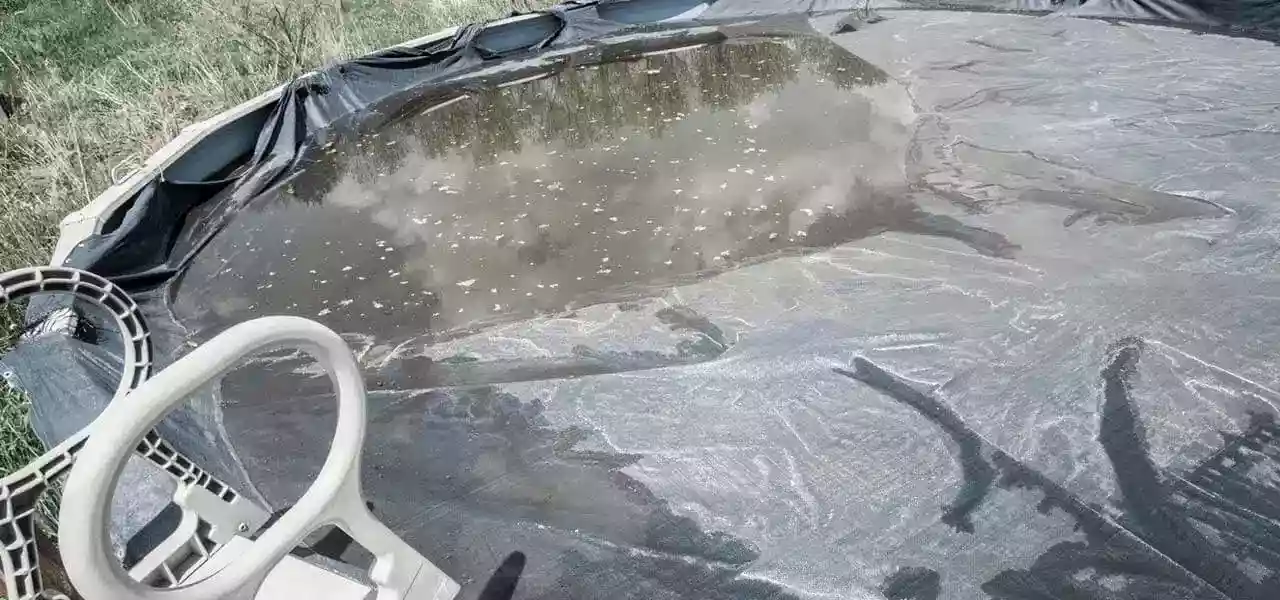FREE Standard Shipping On All Orders $100 or More!*

How to Deal with Mid-Winter Pool Cover Issues
Spring pool opening goes more smoothly when you have a proper winter pool closing. One of the most important parts is putting your pool cover on — tight! A tightly sealed winter pool cover protects the pool from debris and winter conditions. But you can defeat the purpose if the pool cover comes loose and nothing is done about it for many winter months. Put your cover on correctly to avoid a winter pool cover disaster.
Avoid opening the pool in April or May to a sad surprise or shocking realization that you have a lot of clean-up to do. If the pool cover becomes loose or falls into the pool, put on some warm clothes and get it taken care of now.
Winter Pool Cover Issues
- Strong winds can shred loose above ground pool covers in minutes.
- Leaks in the pool can damage a pool cover, or make it fall in the pool.
- Heavy rain and snow can pull in a solid cover, or rip the seam.
- Heavy snow and ice can rip old safety cover straps.
- Ice sheets on a solid pool cover can be sharp on the edges.
- Large sticks or branches can pierce pool covers.
- Farm animals or wild animals can cause severe damage.
My Cover Fell in the Pool
If your solid cover slipped into the pool, either from a pool leak, or too much water weight on the cover — here's how to deal.
With several strong hands, grab the edge of the cover and pull it back up over the pool deck. Weigh it down around the edge with water bags. Start pumping water, using submersible pumps, or a cover pump. Use a vacuum hose to siphon additional water from the pool cover.
Break out the skimmer nets. In fact, leaf rakes are the easiest for debris removal. Pull the debris gently towards you to make for better scooping. Place the debris into a container with holes in it to allow the water to drain.
Scoop out as much as possible by using the leaf rake. A pool brush can also be used to gently pull debris to the edge. If the cover is really submerged deeply, a garden hose vacuum like the Leaf Gulper can be a big help.
After you have eliminated all of the accumulated debris and water from the cover, you can tighten up and reset the pool cover as the surface water recedes. Inspect the cover closely for any holes or tears.
Now you can check on the water. Note how much debris went into the pool. You may be lucky and only have smaller debris in the water. If there is more debris, use your leaf rake or leaf gulper to clean it as much as possible. In any case, once the pool cover and debris situations are stabilized, check and balance the water chemistry.
Winter Pool Cover Repairs
If there is a tear or hole in the cover, you can easily repair it using a pool cover winter patch kit. Cover patches allow for quick fixes on any winter pool cover, so you don’t have to buy a new replacement pool cover.
Solid pool covers can be quickly patched with our pool cover patch as they're self-adhesive and super sticky. Patch both sides of the pool cover for best results.
Small rips or tears of around 6 inches are a prime example of a problem that can be remedied with a pool cover repair patch. The weave of a winter pool cover usually causes pool covers to rip in a straight line, making home repairs simple.
A rip in the cover larger than 12" may not be possible to repair, but you might make it through the winter before replacing the pool cover.
Pool Cover Problem Prevention
For inground pool covers with water bags, keep your cover tight with a good supply of double water bags. Never use bricks to hold down the pool cover or heavy objects. Periodically check on the water tubes throughout the winter season.
A well-functioning pool cover pump will pump the 1–2 feet of rainwater and snow melt that you will likely receive through winter. For above ground pool covers, use cover clips, wall bags, or a cover seal to keep out high winds. Use a cover pump or siphon method to remove excess water that could weaken the cover seams or rip the cover.
Safety Pool Covers
For safety pool covers, if your pool cover straps aren't tight enough, water can accumulate on the surface. Tighten straps so the springs are halfway compressed, and the cover deflects only slightly in the center. Keep your water level between 6"–18" below the safety pool cover.
No matter what pool cover you own – whether it is a mesh cover, solid cover, safety cover or automatic pool cover, take care of winter pool cover maintenance and prevent a mid-winter pool cover disaster.